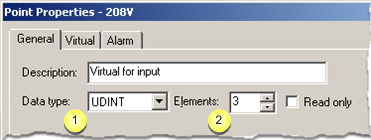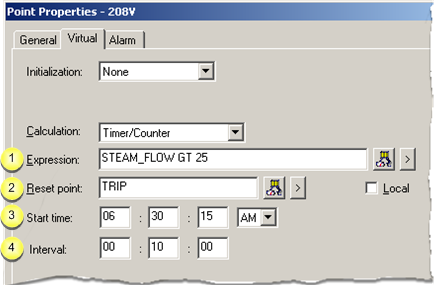A Timer/Counter point records the following data in three array elements:
![]() A count of the number of times the
Expression has transitioned from the LOW state to the HIGH state
since the project started or since the Timer/Counter point was
reset.
A count of the number of times the
Expression has transitioned from the LOW state to the HIGH state
since the project started or since the Timer/Counter point was
reset.
The Expression is in its:
![]() LOW state if its value is less
than or equal to zero
LOW state if its value is less
than or equal to zero
![]() HIGH state if its value is
greater than zero
HIGH state if its value is
greater than zero
![]() The accumulated duration of all
HIGH states, stored in seconds.
The accumulated duration of all
HIGH states, stored in seconds.
![]() 0 or
the time of the last transition to HIGH.
0 or
the time of the last transition to HIGH.
While the Expression is in the:
![]() LOW state, this field contains
zero
LOW state, this field contains
zero
![]() HIGH state, this field contains
the time the Expression transitioned to the HIGH state.
HIGH state, this field contains
the time the Expression transitioned to the HIGH state.
Time is stored in the number of seconds since 00:00:00 on January 1, 1970 GMT (Greenwich Mean Time). If you computer's clock is set for another time zone, this value is translated accordingly. For example, if your computer's clock is set for Eastern Standard Time, the base time is 19:00:00 31 December 1969.
|
General Tab in the Point Properties dialog box. |
|
|
Virtual Tab in the Point Properties dialog box. |
General Tab in the Point Properties dialog box
Selections on the General tab are as follows.

|
Data type |
|
|
Elements |
|
Data type field (General tab) |
Select UDINT.
|
Elements (General tab) |
Select 3.
During runtime, the value of the Expression determines how information is stored in the array.
When the Expression transitions from its LOW state to its HIGH state:
![]() The first element of the array is
incremented.
The first element of the array is
incremented.
![]() The third element of the array is
set to the current system time
The third element of the array is
set to the current system time
![]() The Interval timer starts.
The Interval timer starts.
![]() While the Expression remains in
its HIGH state, the duration time in its second element is
increased at every Interval.
While the Expression remains in
its HIGH state, the duration time in its second element is
increased at every Interval.
![]() When the Expression transitions
from its HIGH state to its LOW state, the third array element is
set to zero.
When the Expression transitions
from its HIGH state to its LOW state, the third array element is
set to zero.
![]() While the Expression remains in
its LOW state, no elements of the array are updated.
While the Expression remains in
its LOW state, no elements of the array are updated.
Virtual Tab in the Point Properties dialog box
Selections on the Virtual tab are as follows.

|
Expression |
|
|
Reset point |
|
|
Start time |
|
|
Interval |
|
Expression |
Enter an expression that will serve as the "edge trigger" for the Timer/Counter.
The expression may contain:
![]() One or more Point IDs as well
as
One or more Point IDs as well
as
![]() Constant values, operations, and
functions.
Constant values, operations, and
functions.
Buttons to help with the equation are as follows.
|
|
Opens the Expression Editor. |
|
|
Displays a Popup menu to: |
||
|
|
|
|
|
Reset point |
During runtime, when the reset point updates, the elements of the Timer/Counter point are reset to 0.
Example
Three Timer/Counter points are updating every 15 seconds
You can define their start times as follows to distribute system load:
|
Point ID |
Start Time |
|
Point1 |
00:00:05 |
|
Point2 |
00:00:10 |
|
Point3 |
00:00:15 |
You want to update the Timer/Counter point every ten minutes while the expression is in the HIGH State.
Enter 00:10:00 in the Interval field to update each Timer/Counter every ten minutes from the time it started.
|
|
While the expression remains high, will
update every |
|
Point1 |
00:00:05 |
|
Point2 |
00:00:10 |
|
Point3 |
00:00:15 |
When the Expression value goes HIGH, the values in the Timer/Counter point are updated. After that, the updates are done every ten minutes.
Note: Buttons to the right of the Reset Point field helps with configuration.
|
|
Opens the Select a Point browser to select an available point. |
|
|
Displays a Popup menu to: |
||
|
|
|
|
|
Start time |
Enter a Start Time that is at least 00:00:01 to be a base start time for the Interval.
The format is hh:mm:ss
Where
hh is the hour,
mm is the minute, and
ss is the second value.
If you have a large number of Timer/Counter points being updated at a high frequency, system performance can be adversely affected. You can use Start Time to distribute their updates to different times and reduce the impact on system performance.
|
Interval |
Enter the time Interval between the Timer/Counter point updates while the Expression value remains HIGH.
The format is hh:mm:ss
Where
hh is the number of hours,
mm is the number of minutes, and
ss is the number of seconds.
|
Step 3.2. Configure virtual calculations. |